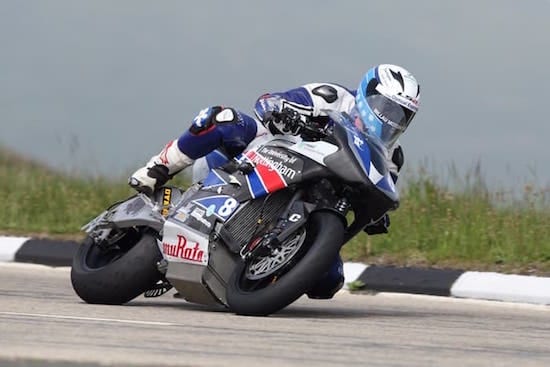
The history and evolution of electric motorcycles is happening before our eyes.
In the short five years I’ve been lucky enough to own a street version, I’ve watched these wondrous machines edging rapidly towards becoming as fast as their fuel injected counterparts.
Perhaps the ultimate test of motorcycles and man is the infamous Isle of Man street race. This ninth year of an electric class showed that although range remains a challenge, speed and power are tantalisingly close.
The electrics are now only 6.5 per cent slower than the superbike race speeds at this 60km, cross country island race. They’ve been gaining at around 2 per cent each year since they started nine years ago when they were 30 per cent slower.
The electric race was won this year by the stunning multi-million dollar Shinden Mugen machine again with a new record 196km average race lap speed – but only just.
Perhaps even more fascinating was the second placed University of Nottingham team who came in at 191kmh on their university built bike.
I spoke with Team Manager and University academic Miquel Gimeno-Fabra recently while he was rebuilding the bike for its next race in the US, which provided incredible insights into what’s been happening behind the scenes.
“Miq” (as he is known) explained in passionate terms how the UoN was driven to create a team which has now become the second fastest electric motorcycle to lap the IoM TT in its history.
Driven by a couple of motorsports fanatic lecturers and enthusiastic students, their aim was to bring together the skills, technology and passion and see what they could do. After only four short years they have built their latest UoN bike entirely from the ground up, a remarkable achievement.
“The first year we went the TT we literally started only two or three months before the race with no clue what we were doing,” he said laughingly. “We arrived never having tested the final configuration, but we had faith in our modelling, predictions and team. We finished 5th and now we are hooked”.
The team’s original bikes started out with many off-the-shelf parts, but over time ex-students who have landed roles in amazing tech companies due to their experience are coming back as collaborators with stunning results. The motors, batteries, controllers and software are all made to their specifications with the results proving their credibility again this year.
“After our first big success” he said, “we essentially had to reverse engineer the whole bike to work out what we did!”
Miq explained how incredibly powerful electric motors are now relatively easy to get (relatively) but that the control systems and battery designs are increasingly the primary barrier to yet more power and speed.
Their motors can deliver in excess of 200kW in a 45kg package and, hence, their controllers need to deliver incredible, manageable power levels in compact and efficient packages. At the TT their bike weighed around 290kG in total which is just remarkable.
Miq explained that they had made huge strides in motors and controllers but are still on the ragged edge of what’s possible and then there are the batteries.
UoN doesn’t use any fancy air or liquid cooling on its custom made battery packs – an advantage in their eyes.
“The complexity, bulk and weight of cooling systems just doesn’t add up to us” Miq said. “We accept that in pushing this hard, we will potentially destroy the pack by the end of the race – the demands are that huge”. But every time they push them this hard they learn more.
It’s a virtuous cycle of power and learning, and they just keeping getting better at it.
“All the electrics, including Mugen, are struggling with thermal limits on batteries” he said. “In delivering so much energy – or accepting regenerative energy at those levels, the batteries become a huge thermal mass.”
Mugen apparently ran huge levels of regen at this year’s TT, exasperating thermal stresses. Right now, managing this is the number one barrier to going faster and further in racing.
“Even the Tesla pace car with its fancy battery thermal management systems was overheating at the IoM. It’s probably the worlds harshest test which is exactly why we chose it.”
In the high-end racing world, the bikes are designed to arrive at the finish line empty, enabling smaller packs but necessitating highly advanced engineering.
Typically, they are in the range of 15-25kWh for such races, similar to the hi end Zero electric motorcycle I own. However, they hit the battery with almost 10 times the power demand and are capable of a mind warping 1200Nm of torque after gearing to the rear wheel.
It’s no wonder some of the world’s best and bravest riders are starting to line up for a ride.
For now, he told me, lithium cells remain the best and most practical choice. They are watching new technologies very closely but suspect that lithium will continue to dominate, at least for the next few years.
Lessons are being learned with the risks of lithium batteries in such high power densities, too. The University of Bath team learned this the hard way in 2018 when they apparently may have miscalculated the thermal expansion of their battery pack causing their bike to burn to the ground in a spectacular and expensive demonstration of the risks in an accidental fire.
“Battery construction is a critical element of reliability,” Miq told me. As the Bath team found out, the only thing you can do with a burning lithium bike is get it somewhere safe, douse it as much as possible and wait for it to incinerate itself. And your transport van too, in Team Bath’s case.
Miq was almost passe about the risks and costs.
“This is motorsport. Stuff happens, and it has to be taken seriously, but we just focus on design, learning and minimising risk. Winning and developing this technology is our goal but our advantage is that we don’t have massive corporate brand that could be tarnished with a catastrophic fire” he said.
“Mugens close lineage to Honda more than likely tempers their willingness to run right to the ragged edge like us,” Miq quipped. “We are all about learning and able to be ballsier.”
Miq also described how the University has successfully created a “must do” course for any budding tech/motor/speed head student which results in impressive, dedicated students who go on to the wider world, bubbling with the thrills and experience from the motorsport of the future.
This, in turn, brings more collaboration and investment into the University meaning they can leverage it up.
“It’s not about building production bikes. It’s about learning, pushing technology and the pursuit of motorcycle speed” he said. Amen to that!
The team runs several configurations and has worked consistently with two riders on fine tuning the bike to suit their demands, one at the TT and one at Pikes Peak.
US racing legend Jerimiah Johnson, for example, will run a smaller battery pack for “the second most ridiculous, dangerous and harsh” race next to the IoM, the Pike’s Peak Challenge.
Miq was extremely cagey about exactly how the bike was set up for this race scheduled for June 20, but did say the bike was substantially lighter. It’s entirely possible we may see more records set at Pikes Peak this year, either through UoN or the sole other electric motorcycle race team that has made it this far.
It’s several years since a high-end electric bike has had a clean run at the Peak and the last time it happened the electric beat the next nearest bike by 20-something seconds, leaving some octane stained jaws on the ground.
The Lightning machine still lays claim to numerous world records and was originally designed as the testing ground for a hyper sports road bike. Despite selling a handful of bikes, Lightning appear to be suffering the curse of being on the absolute cutting edge and have been in hibernation for a few years now – but built an amazing machine which I have personally drooled over before.
Given the progress and learnings, it’s highly probable that if everything goes right, this will be improved on substantially.
Miq was busy preparing to re-assemble their battery pack after it had arrived at Pikes Peak with just days to spare, before things get really serious. “We never sleep” he joked.
“We are just passionate about building the fastest electric motorcycles in the world. I better go,” he said.
God speed UoN!











